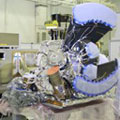Over the last year, engineers have been carefully testing and piecing together the multitude of components that make up Sentinel-3. The recent arrival of the infrared radiometer is a milestone in the exacting process of building this upcoming Copernicus mission.
Over the last year, engineers have been carefully testing and piecing together the multitude of components that make up Sentinel-3. The recent arrival of the infrared radiometer is a milestone in the exacting process of building this upcoming Copernicus mission.
The Sea and Land Surface Temperature Radiometer, or SLSTR, just delivered to Thales Alenia Space in Cannes, France, is one of the main instruments carried on Sentinel-3. As its name suggests, this new sensor will map the surface temperature of Earth's land and oceans.
Drawing on sound heritage from Envisat's Along Track Scanning Radiometer, this improved instrument will provide Copernicus users with timely and accurate information for maritime safety, weather services and climate monitoring. Developed by Selex ES in Italy, it also includes novel detectors for monitoring wildfires.
The Sentinel-3 mission is designed as a two-satellite constellation for optimal global coverage and data delivery. Sentinel-3A is expected to be launched in mid-2015 and Sentinel-3B will follow about 18 months later.
